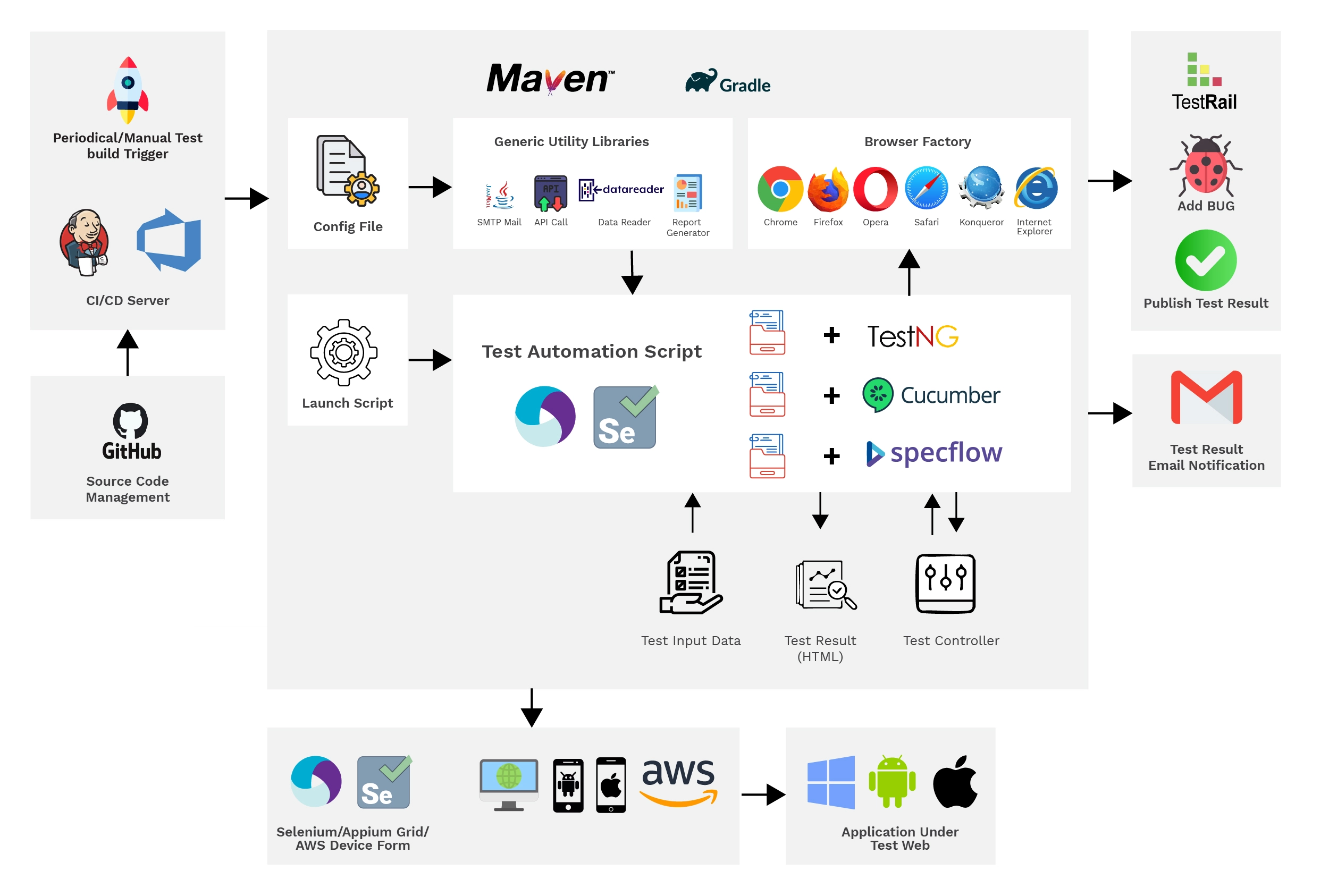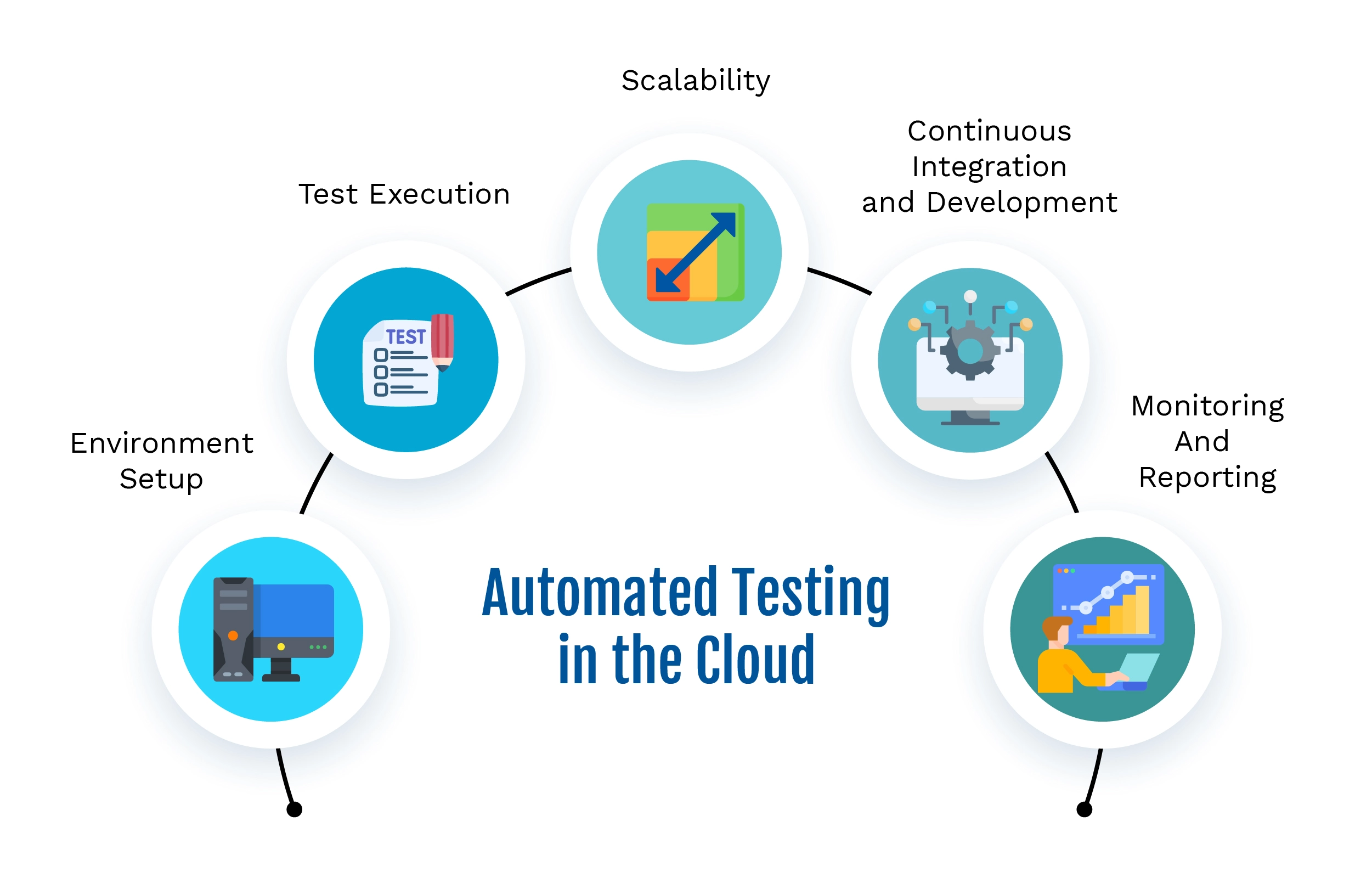As cloud computing becomes increasingly essential, organizations are rapidly adopting it to enhance efficiency and streamline operations. This transformative technology is revolutionizing the way tasks are completed, enabling businesses to achieve greater productivity and scalability. Testing is a significant component of the software development lifecycle, and cloud computing can significantly contribute to completing it within the required timeframe.
Cloud-based automated testing revolutionizes software development by leveraging scalable cloud environments for efficient, on-demand testing. It enhances agility through rapid provisioning of test resources, facilitates comprehensive test coverage across various scenarios, and accelerates time-to-market. Despite challenges like data security and integration complexities, the benefits—cost efficiency, scalability, and improved software quality—make cloud-based automated testing indispensable for modern businesses aiming to optimize their testing processes and deliver robust, high-performance software solutions.
What is Automated testing in the cloud?

Fig1: Automated Testing Framework in Cloud
Automated testing in the cloud refers to the practice of using cloud-based resources and environments to automate the execution of test scripts and scenarios for software applications. This approach leverages the scalability, flexibility, and accessibility of cloud computing services to conduct various types of automated tests, such as functional testing, regression testing, performance testing, and more. By adopting automation testing in the cloud, organizations can enhance agility, reduce testing cycle times, improve software quality, and effectively meet the demands of modern software development practices.
Cloud-based test automation offers several advantages for organizations. Firstly, cloud testing tools provide extensive coverage across various platforms, browsers, and devices, supporting different versions seamlessly. This broad support is only possible with cloud-based solutions.
Parallel execution is a key benefit, as cloud testing tools allow running the same test scripts simultaneously on multiple browsers or devices. This capability substantially reduces execution time for compatibility checks across different environments. Scalability is another crucial advantage, as cloud providers offer flexible options to quickly adjust configurations. Many services also provide the convenience of month-to-month licensing.
Additionally, cloud services facilitate continuous delivery by integrating with CI/CD tools like Jenkins and Azure Pipeline. This integration enables automation tools to run immediately after any deployment or code changes, ensuring a smooth and efficient workflow. Cloud computing allows payment only for the actual time used, eliminating maintenance overhead since the service provider handles build execution and updates. This leads to cost efficiency. Some tools are even available for free for open-source projects.
The market offers a wide range of cloud testing tools, including Sauce Labs, SeeTest Cloud, Browser Stack, and AWS Device Farm. These tools feature capabilities such as recording test execution, generating test reports, capturing screenshots of failures, and integrating with various automation tools like Appium and Selenium, as well as CI/CD tools like Jenkins and Azure Pipeline.
Organizations can leverage a specific cloud automation architecture for their projects to maximize efficiency and flexibility. For example, when automating mobile applications, a tool like SeeTest Cloud Experitest, which specializes in mobile devices and supports both Android and iOS, can be selected. The chosen cloud testing tool is then integrated with the automation scripts. Many automation tools provide options for integration with cloud devices, either through access keys or by specifying integration details directly in the scripts.
Cloud devices also offer element locator features. For example, to locate a login element, you can view its properties such as ID, text label, name, and class. You can then extract the unique XPath to use in your test scripts. Automation scripts can be managed using a cloud repository like GitHub, where each branch contains a set of automation scripts.
Additionally, the cloud repository can be integrated with a CI/CD tool. By creating a new pipeline and linking the Git repository, the pipeline can be configured to execute test automation scripts from the repository. During execution, the pipeline runs the tests, generates reports, and finalizes the job. Successful builds and passing test cases are documented in detailed reports, providing a step-by-step account of the test execution, complete with screenshots, ensuring transparency and clarity in the testing process.
Cloud testing focuses on essential components such as:
- Application Testing: Involves evaluating aspects such as functionality, comprehensive business processes, data protection, and compatibility with different web browsers.
- Network Testing: Focuses on assessing various network conditions, protocols, and the reliability of data transmission across networks.
- Infrastructure Testing: Encompasses validation of disaster recovery procedures, backup systems, secure connectivity, and storage policies, ensuring compliance with regulatory standards.
Key aspects of automated testing in the cloud include:

Fig2: Key aspects of Automated testing in Cloud
- Environment Setup: Utilize cloud computing services to provision testing environments on-demand. This allows teams to quickly set up multiple test configurations without the need for dedicated hardware or infrastructure.
- Test Execution: Automate the execution of test scripts and scenarios in the cloud environment. This includes functional testing, regression testing, integration testing, and more, ensuring comprehensive test coverage.
- Scalability: Take advantage of the scalability of cloud platforms to handle varying loads and simulate real-world conditions. This capability is beneficial for testing applications under different levels of user traffic and data volumes.
- Continuous Integration and Deployment: Integrate automated tests into the CI/CD pipeline to facilitate continuous testing and faster release cycles. Cloud-based automation enables seamless integration with development processes for efficient software delivery.
- Monitoring and Reporting: Monitor test execution and performance metrics in real-time. Cloud-based testing tools often provide detailed analytics and reporting functionalities to track test results, identify issues early, and optimize testing strategies.
How to Perform Automated Testing in the Cloud
Automated testing in the cloud offers scalability, flexibility, and efficiency for modern software development. Here’s a detailed guide on how to perform automated testing in the cloud:
- Select the Right Cloud Provider: Choosing a cloud service provider is the first step. Providers like AWS, Azure, and Google Cloud offer robust infrastructure and services tailored for testing needs. Evaluate them based on scalability, reliability, cost, and support for various testing tools.
- Choose the Appropriate Testing Tools: Select cloud-compatible testing tools. Popular choices include:
- Selenium: For web application testing.
- Appium: For mobile application testing.
- JUnit: For Java applications. Consider platforms like Sauce Labs, Browser Stack, and AWS Device Farm for comprehensive testing solutions.
- Set Up Your Testing Environment: Provision of the necessary infrastructure in the cloud. This includes virtual machines or containers to host your application and testing tools. Configure this environment to mimic your production setup closely to ensure realistic testing conditions.
- Develop and Organize Test Cases: Write automated test scripts covering various scenarios such as functional, performance, security, and compatibility tests. Use test management tools to organize and track these cases, ensuring comprehensive coverage.
- Integrate with CI/CD Pipelines: Integrate your automated tests with CI/CD pipelines using tools like Jenkins, GitLab CI, or CircleCI. This automation ensures tests run with each code change, maintaining code quality and accelerating the deployment process.
- Execute Tests on the Cloud: Run your automated tests in the cloud infrastructure. Utilize cloud’s scalability to run tests in parallel, significantly reducing the total testing time. Monitor test execution in real-time using dashboards provided by your testing tools or cloud provider.
- Analyze Test Results: Collect and analyze the results to identify issues or areas needing improvement. Cloud-based tools often offer detailed reports and analytics, providing insights to refine your testing strategy and application quality.
- Ensure Data Security and Compliance: Implement robust security measures to protect sensitive data during testing. This includes encryption, secure access controls, and compliance with regulations like GDPR and HIPAA. Regularly review and update these practices to address emerging security threats.
- Maintain and Update Test Scripts: Regularly update your test scripts to adapt to changes in your application. Use version control systems to manage these scripts, ensuring your testing remains effective and up to date.
- Leverage Cloud-Specific Features: Optimize your testing process by leveraging cloud-specific features such as auto-scaling and serverless computing. These features allow dynamic resource allocation based on testing needs, enhancing efficiency and cost-effectiveness.
Types of Cloud Testing
Cloud testing can be broadly categorized based on its specific objectives within the software testing lifecycle.
- Performance Testing: Measures how well applications scale, maintain reliability, and operate efficiently within cloud environments.
- Load Testing: Evaluates the application’s performance when subjected to expected user traffic.
- Stress Testing: Identifies the application’s breaking points by exposing it to extreme and complex workloads.
- Security Testing: Examines the security measures of applications, focusing on data protection and vulnerability assessments.
- Compatibility Testing: Confirms that the application functions correctly across various environments and cloud services.
Challenges of Cloud Automated Testing
While cloud automated testing offers numerous advantages, it comes with a set of challenges that organizations must navigate:
- Data Protection and Privacy: The multi-tenant nature of cloud environments increases the risk of data theft, making data protection a critical concern. Providers must offer robust assurances and strategies to secure sensitive information.
- Interface Compatibility Issues: Upgrades by cloud service providers can change external interfaces, causing difficulties for users accustomed to previous versions. Ensuring users can select their preferred interface version is essential.
- Data Transfer Complexities: Migrating data between cloud providers is challenging due to differing database schemas. Understanding and mapping data fields and relationships requires considerable effort to ensure seamless data migration.
- Integration of Enterprise Applications: Validating data integration between client networks and SaaS applications is crucial. This includes ensuring data privacy and extensive validation of both outbound and inbound data to reassure users of their data’s security.
- Simulating Real-World Upgrade Testing: Ensuring that live upgrades do not disrupt existing SaaS users is one of the most notable challenges. Simulating real-world scenarios to test upgrades without affecting user experience is critical.
- Limited Control: Organizations have less control over cloud testing environments compared to in-house setups. This limited control can hinder customization and specific testing needs.
- Network Dependency: Reliance on internet connectivity introduces the risk of latency issues, which can disrupt testing activities. Ensuring stable and robust network conditions is vital for effective cloud testing.
Addressing these challenges necessitates careful planning, selecting reliable cloud providers, and utilizing automation testing tools designed for cloud environments. By proactively managing these issues, organizations can leverage the benefits of cloud automation testing effectively.
Conclusion
Cloud-based automated testing represents a major advancement in software development, offering numerous benefits such as scalability, cost-efficiency, and enhanced test coverage. By leveraging cloud environments, organizations can perform comprehensive testing more rapidly and flexibly, ensuring that applications meet high standards of quality and performance.
Despite the challenges, including data security concerns and integration complexities, the advantages of cloud automation testing are compelling. It allows for continuous integration and delivery, real-time monitoring, and efficient use of resources, ultimately leading to faster release cycles and more robust software solutions.
To successfully implement cloud-based automated testing, it is necessary to select appropriate cloud providers and testing tools, integrate with CI/CD pipelines, and ensure data security and compliance. Addressing the challenges through careful planning and utilizing the unique features of cloud platforms can help organizations optimize their testing processes and achieve their software quality goals.
As the software development landscape continues to evolve, cloud-based automated testing will remain an indispensable tool for modern businesses striving to deliver high-performance, reliable software in a competitive market.
Know More: Cloud Testing Services












